The Dynamics of Wave Braking in Surfing Explained
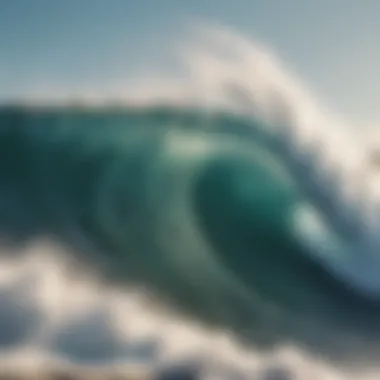
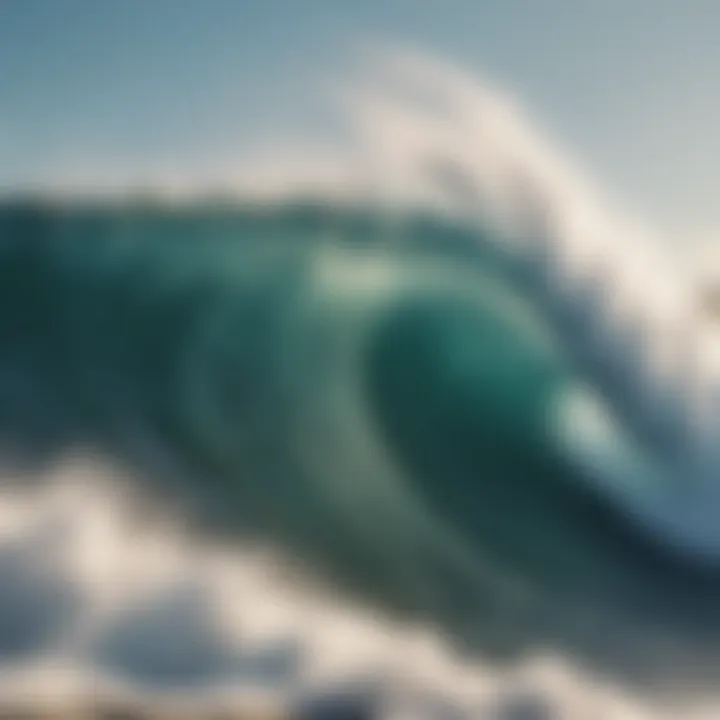
Intro
In the world of surfing, few aspects are as vital to a surfer's experience as the behavior of ocean waves. Whether you’re a fresh-faced novice looking to catch your first wave or a seasoned rider hitting the big swells, understanding how waves brake can make all the difference. Not only does wave braking dictate the type of ride you can expect, but it also ties closely to safety, performance, and overall enjoyment.
As we dive deeper, you’ll discover not just the mechanics behind wave breaking, but also how factors like coastal geography and weather systems come into play. Picture the moment a wave begins to rise, crests, and finally crashes in a dizzying display of frothy energy—this spectacle is not merely a captivating sight, it’s a dance of physical forces influenced by the earth’s contours and atmosphere.
This introductory section aims to lay the groundwork, highlighting the relevance of mastering wave dynamics to enhance your surfing skills. From beginners to skilled surfers, having a solid grasp on this subject is essential—not only for improving technique but also for fostering a deeper appreciation of the ocean's behavior.
Surfboarding Techniques
Surfing is as much an art as it is a sport. Each surfer develops their unique style, influenced by personal skill levels and the nuances in wave behavior. Here, we will break down the techniques suitable for both beginners and seasoned surfers alike.
Beginner Tips for Mastering the Basics
For those just dipping their toes into the world of surfing, consider these fundamental techniques:
- Paddle Positioning: Keep your body centered on the board to maintain balance while paddling out. Too far back, and you might miss the wave; too far forward, and you risk nose-diving.
- Wave Timing: Recognize the rhythm of incoming waves. Look for smaller waves to start with, learning how to pop up and ride before stepping up to bigger swells.
- Foot Placement: When standing up, place your feet shoulder-width apart and position your back foot directly over the fins for greater control.
- Focus on Balance: Work on core strength and balance through exercises like yoga, which can significantly improve your stability on the board.
Advanced Techniques for Seasoned Surfers
Once you're comfortable on your board, advance your skills with these techniques:
- Wave Selection: Train your eye to identify which waves are worth riding. Look for waves breaking in your favor and avoid choppy waters.
- Bottom Turn Mastery: Perfecting your bottom turn is crucial in maintaining speed and control while transitioning into the wave face. It's all about leaning into the turn while keeping your weight centered.
- Drawn-Out Carves: Learn to carve smoothly by shifting your weight and using your legs to direct the board’s movement.
- Tube Riding: This is the ultimate goal for many surfers. Practice your positioning to maximize your chance of getting inside the wave and experiencing that thrilling feeling of being enveloped by the water.
Surfboard Equipment
A good surfer is only as good as their surfboard and gear. Let’s explore the essentials that can seriously elevate your game in the water.
Reviews of the Latest Surfboards on the Market
Keeping up with the latest surfboard designs can be invaluable. Here are a couple of notable options:
- Soft Top Surfboards: Ideal for beginners, these boards are forgiving and provide extra buoyancy, making them perfect for learning balance and technique without too many wipeouts.
- Shortboards: For advanced surfers, these boards allow for quick maneuvers and tighter turns. Brands like Channel Islands or Lost Surfboards are renowned for their performance-focused designs, offering great responsiveness on the wave.
- Longboards: Perfect for a laid-back cruising style. Companies like Bic or Mahal Surfboards produce reliable longboards that appeal to riders who enjoy smooth, graceful rides.
Essential Gear for Every Surfboarder
Beyond the board, there’s equipment that can optimize your surfing experience:
- Surf Leash: Never underestimate the importance of a good surf leash to keep your board from drifting away during wipeouts.
- Wetsuit: Choose one that suits the water temperature in your favorite surf spots. A well-fitted wetsuit allows for better flexibility and warmth.
- Wax: Different types of wax exist for varying water temperatures. Ensure a solid grip by applying the right wax to your board.
"Understanding the dynamics of wave braking not only keeps you safer but also significantly boosts your performance on the water. A educated surfer is often a successful surfer."
Culmination
This exploration of wave braking dynamics will empower you to enhance your surfing proficiency. From novice tips to advanced techniques tailored for seasoned surfers, this knowledge is critical not just to elevate your performance but also to deepen your connection to the ocean. In the subsequent sections, we will further dissect the various factors influencing wave behavior, giving you the tools to read and ride waves with newfound confidence.
Preamble to Wave Braking
Wave braking is at the heart of any surfer's experience, shaping how they ride the waves and interact with the ocean. This complex phenomenon offers not just a thrilling ride but also insights into the mechanics of water and air, the ocean's ever-changing temperament, and the science behind surf conditions. Understanding wave braking goes beyond merely catching a wave; it's about recognizing its critical aspects—from the type of wave breaking to its energetic dynamics.
When surfers grasp these fundamentals, they can enhance their skills significantly, making the difference between a haphazard struggle and a smooth glide. Those fascinated by the ocean, whether they're seasoned surfers or just beginning, stand to benefit from knowledge about wave braking. It raises awareness about the finer details that dictate surf quality, equipping surfers with the necessary tools to read the ocean effectively.
Moreover, delving into wave braking opens a window to marvel at the natural forces at play. The dynamics of waves are not merely abstractions; we'll explore how physical conditions, such as wind and bathymetry, interact in a living, breathing system.
Definition and Importance
Wave braking occurs when ocean waves approach the shore and begin to lose their energy, transforming from taller, fast-moving waves into crashing foam. This process is pivotal for surfable waves since it dictates how and when a wave will break. In practical surfing terms, these variations influence the choice of surfing spot, the timing for paddling into the wave, and ultimately, the surfing experience.
**Importance:
- Shapes Surf Conditions**: Different types of wave breaking—like plunging, spilling, and collapsing—affect how rideable and enjoyable a wave will be.
- Improves Safety**: An understanding of wave braking aids surfers in identifying dangerous conditions, reducing the risks associated with surfing.
- Influences Skill Development**: Surfers can refine techniques tailored to specific wave types, enhancing control and increasing proficiency.
"> Knowledge of wave braking not only heightens your surfing prowess but also brings about a deeper appreciation for the ocean's rhythm.
History of Wave Dynamics Study
The study of wave dynamics is not a new venture; it stretches back into the depths of time. It’s fascinating to note that early civilizations, especially those near coastlines, had to observe and recognize the rhythms of the sea. Surfing itself, particularly in places like Hawaii, has ancient roots, as early Polynesians designed boards to ride waves. However, systematic research on waves and their dynamics began much later.
In the 19th century, scientists sought to unravel the mysteries of ocean waves—they looked into how stresses, such as wind, interact with water surfaces. Notably, the foundation laid by figures such as Lord Rayleigh in fluid dynamics marked significant progress.
As technology advanced, so did the tools at researchers' disposal. In the late 20th century, computational models and satellites allowed for groundbreaking studies and real-time tracking of wave patterns. These developments opened up a treasure trove of knowledge, offering insights into both the mechanics of waves and their relationship with global climate phenomena.
Presently, researchers continue to explore how different factors influence wave behavior and, by extension, surf conditions. This ongoing study incorporates environmental science, oceanography, and surf culture, illustrating a complex tapestry that melds nature and recreation.
The Mechanics of Waves
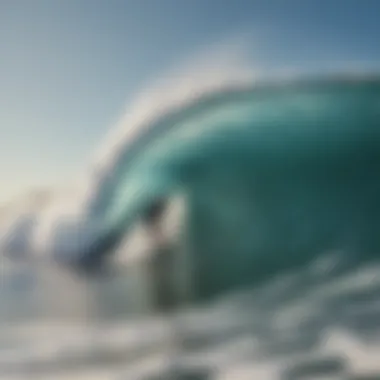
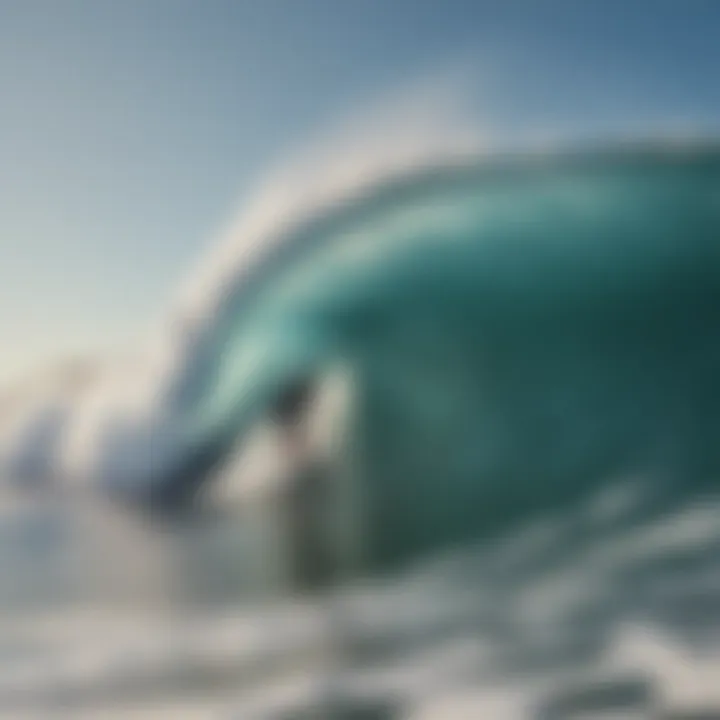
The mechanics of waves play a pivotal role in understanding surf conditions, especially how they affect wave braking. When it comes to surfing, knowing the intricacies of wave formation and their various types can make a world of difference. It’s not just about having fun in the water; it’s about harnessing the power of waves intelligently. A surfer's ability to read waves is sharpened by understanding these mechanics deeply, which allows them to predict breaking waves and improve their surfing experience.
Wave Formation Process
Wind Influence
Wind is the primary force behind wave formation, acting as the initial catalyst that generates ripples on the surface of the water. The friction between the wind and the surface layer creates energy, which subsequently evolves into larger waves. One key characteristic of wind influence is its strength and duration. Strong winds over longer periods contribute significantly to increasing wave heights and energies.
In this article, acknowledging wind's crucial role is fundamental. The unique feature here is its variability; different wind patterns can lead to diverse wave conditions. For instance, onshore winds can make the waves choppy, whereas offshore winds often produce cleaner, more well-formed waves, making them a more favorable option for surfing.
Advantages of understanding wind influence include better forecasting of surf conditions. When surfers can gauge the wind’s direction and speed, it can enhance their riding experience significantly.
Fetch Distance
Fetch distance is another important contributor to wave formation. This term refers to the length of ocean surface over which the wind blows. The longer the fetch, the more energy waves can acquire before reaching the shore. A significant aspect of fetch is its impact on wave consistency. Longer fetches tend to produce more powerful swells, ideal for surfers looking for robust and rideable waves.
The distinctive feature of fetch is that it varies with geographical location. Coastal areas with expansive fetches often experience swell-building winds, while enclosed bays may not exhibit the same conditions. This can be a limiting factor for surfers wanting optimal wave conditions.
In this context, understanding fetch helps surfers choose locations that promise a better surfing experience, positioning them to take advantage of more powerful waves as they're generated far out in the ocean.
Depth of Water
The depth of water also significantly influences wave mechanics. As waves approach shallower water, they interact with the ocean floor, and this interaction causes waves to slow down, increase in height, and eventually break. A key characteristic of water depth is its influence on wave shape and breaking behavior. The depth impacts whether a wave will form a steep slope or a gentle rise, which in turn affects how the wave can be ridden.
What's particularly interesting is the variability in ocean floor topography. Areas with complex underwater structures can create unique wave breaks not seen elsewhere, offering surfers various challenges and opportunities.
Thus, understanding water depth not only aids in predicting where and when waves will break but also enhances safety by keeping surfers informed about potentially hazardous areas.
Types of Waves
Capillary Waves
Capillary waves characterize the smallest type of wave, formed mainly by light winds. They are usually short-lived and maintain low amplitude. Their significance lies in their ability to initiate larger wave formations. A key feature of capillary waves is that they help in the energy transfer from wind to surface water, which is a crucial step in the wave formation process. Though they might not be the focus for surfers, they provide insight into the ocean’s surface dynamics and are indicators of evolving wave conditions.
Gravity Waves
Gravity waves are those whose heights are influenced primarily by gravity; this means they can grow considerably larger than capillary waves. Gravity waves form when winds create disturbances over greater fetches or stronger winds. Their defining characteristic is their ability to maintain energy over longer distances, making them the type of wave surfers often seek.
Surfers benefit from understanding gravity waves since they indicate the potential for surfable conditions. These waves often break in various styles, making them crucial for a good surfing experience.
Surface Waves
Surface waves are the most recognized as they are what surfers ride. They represent the interaction between the wind and the water's surface, generating larger swells capable of travel across vast distances. A defining feature is their ability to break on shores, creating ideal riding conditions. Their advantages encompass the various forms they take depending on factors like wind strength, fetch distance, and water depth.
Knowing these types of waves helps surfers improve not just their riding techniques but also their decision-making regarding when and where to surf. Recognizing surface waves can enhance the overall surfing experience by allowing surfers to position themselves effectively for optimal rides.
"Understanding wave mechanics is not just about physics; it's about connecting with the ocean and mastering its rhythm."
Grasping these concepts enables surfers, instructors, and adventurers alike to appreciate the complexities involved in wave dynamics, leading them to better choices both in safety and performance.
Mechanics of Wave Braking
Understanding the mechanics of wave braking is essential for surfers looking to optimize their riding experience. It encompasses how waves interact with the ocean floor and how they behave when reaching shallower waters. This interaction is more than just a show of force; it influences the power and shape of the waves, which in turn feeds into the surfer's ability to harness that energy for their performance. Each type of wave break presents unique opportunities and challenges, making it vital for surfers to grasp these concepts to read the ocean effectively.
Stages of Wave Breaking
Plunging Break
A plunging break occurs when the wave steepens significantly as it approaches shallow water, resulting in the crest curling over the base and crashing down into the water below. One of the defining characteristics of a plunging break is its powerful, hollow wave structure, which often creates a thrilling ride for more experienced surfers. This type of break is particularly coveted because it can facilitate barreling waves, where surfers experience the thrill of riding inside the hollow of the wave.
However, the power behind plunging breaks can also pose risks, especially to novice surfers. The intensity with which the wave crashes can be disorienting, and if mismanaged, it can lead to wipeouts or worse. Knowing how to navigate this type of wave means understanding its speed and trajectory.
Spilling Break
In contrast to the plunging break, a spilling break has a more gradual slope. As the wave rolls into shallower waters, it spills over gently rather than crashing fiercely. This characteristic makes spilling breaks typically easier to ride, as surfers can often catch them with less risk of injury. Moreover, these types of waves generate more consistent surfing conditions, attracting beginner surfers learning the ropes.
Despite its advantages, spilling breaks might lack in terms of excitement compared to plunging breaks. They tend to have less power, so surfers seeking adrenaline might not find them as satisfying. Understanding when to choose a spilling break can be key for surfers looking to hone their skills without the heightened risk.
Collapsing Break
The collapsing break is somewhat of a hybrid between plunging and spilling waves. It occurs when the wave breaks suddenly and violently but does not form a hollow wave barrel. One might describe the experience as explosive but less predictable than a plunging break. The key characteristic of a collapsing break is its suddenness; a wave may appear misleadingly tame only to collapse into a chaotic swirl once it nears the shore.
While this type of break does offer a thrilling ride, the unpredictability means it can be tricky to manage. Surfing a collapsing break requires quick reflexes and an experienced read of the wave. Surfers willing to take on this challenge will often find exhilarating rides, but proper understanding and respect for its nature are paramount.
Factors Influencing Wave Break
Wave Height
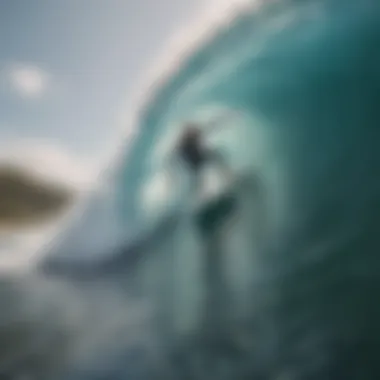
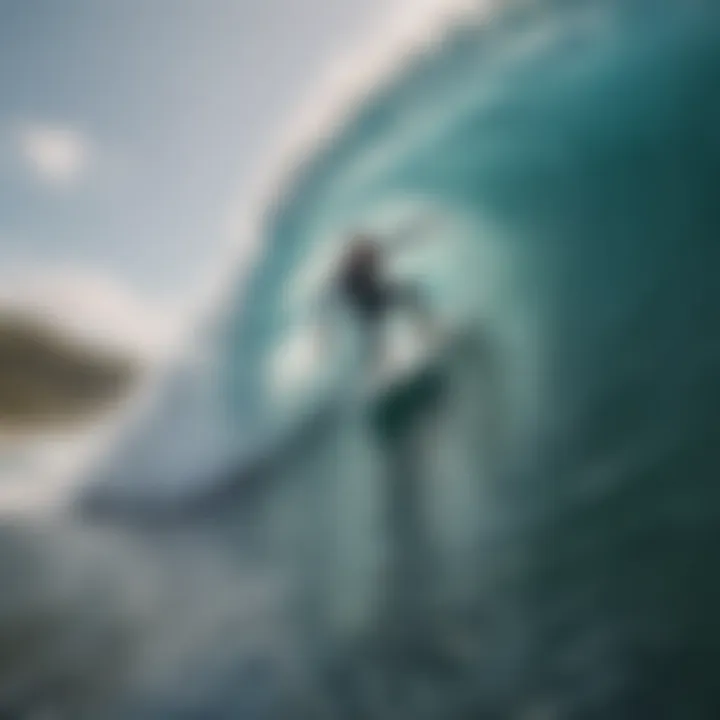
Wave height significantly impacts how waves break, dictating both the power and the shape of the wave during its approach. Taller waves can induce higher energy upon breaking, often leading to more dramatic and powerful breaks. For surfers, understanding wave height can be crucial for assessing skill level; larger waves are generally suited for more advanced surfers, while those that are smaller may provide a safer environment for younger or inexperienced riders. Knowing where to gauge the optimal height can provide a fantastic surf experience.
Wave Period
The wave period, defined as the time it takes for consecutive waves to pass a fixed point, plays a critical role in wave dynamics. A longer wave period often means that the waves are more organized and have greater potential energy. This organization results in smoother rides and more consistent waves. Understanding the wave period helps surfers determine when to paddle out, as longer periods may suggest more powerful and less choppy conditions. Conversely, shorter periods can indicate erratic waves, which could complicate surfing attempts.
Bathymetry
Bathymetry refers to the underwater topography and the variation in ocean floor depth. It is vital in determining how waves will break when they approach shore. Different features, like underwater reefs or sandbars, alter the wave's trajectory and can lead to diverse wave breaks in a relatively small area. Surfers should pay heed to bathymetric maps or even scout local breaks to identify features that can enhance or diminish the surf quality.
Wave dynamics is not just about riding; it's about understanding the rhythm of the ocean, the dance between water and land.
Environmental Influences on Wave Dynamics
The interaction between the ocean's surface and its surrounding environment plays a pivotal role in shaping wave behavior. Understanding Environmental Influences on Wave Dynamics is essential for surfers aiming to maximize their experience on the water. Several key elements like wind patterns, ocean currents, and tides profoundly affect the formation and characteristics of waves. Each of these factors can determine not just the quality of the waves but also the safety and predictability of surfing conditions.
Wind Patterns and Their Effects
Winds are the primary drivers of wave generation. When wind blows across the water's surface, it can transfer energy, creating waves. The strength and consistency of these winds significantly influence wave size and shape. For instance, if you’ve ever noticed larger swells following a storm, it’s because strong, steady winds create longer fetches, meaning they blow over greater distances and build more energy before hitting the shore.
Moreover, wind direction matters a lot. Offshore winds, which blow from land to sea, can help in grooming the waves, aligning their crests and creating cleaner, more surfable conditions. In contrast, onshore winds, blowing from the ocean towards the land, often produce choppy and less desirable wave conditions for surfers.
"Understanding how wind patterns play a role in wave dynamics is like reading the ocean’s mood—each gust tells a different story about what lies ahead.”
Impact of Ocean Currents
Ocean currents are like the highways of the sea, moving water from one location to another, and they have a substantial impact on wave behavior. For surfers, these currents can influence not only wave size but also the intensity and direction of waves. Warm currents can create localized weather effects, altering wind patterns and therefore affecting wave formation.
Additionally, currents can modify wave energy as they interact with breaking waves. Currents can either enhance or inhibit the power of waves approaching the shore. When a wave meets a current flowing in the opposite direction, it can lead to shorter, more chaotic breaking, making surfing more challenging. Knowledge of local currents can be a gamechanger for surfers; they offer insights into where and when to catch the best waves.
Role of Tides
Tides, driven by the gravitational pull of the moon and the sun, are another critical variable in wave dynamics. As tides rise and fall, they can significantly alter the surfing landscape. At high tide, waves might break differently than at low tide, revealing or obscuring underwater structures like reefs. For surfers, this means adapting their techniques and surf spots based on the time of day.
Tides can also affect the swell size; for instance, some breaks work best during high tide while others may offer optimal conditions at low tide. Being attuned to local tidal patterns can enhance a surfer’s experience by informing decisions about where to surf and at what time.
Wave Braking and Surfing
Wave braking plays a pivotal role in the surfing experience. Not just a matter of catching a wave, it’s about understanding how the waves behave as they approach the shore. This understanding can be the difference between a successful ride and a wipeout. For surfers, recognizing wave braking dynamics can significantly enhance their ability to predict conditions, optimize their surfing techniques, and even ensure their safety in the water.
Reading the Ocean
Understanding the ocean is a core skill for any surfer hoping to excel. It’s not merely about paddling out and waiting for the next big one; it requires a keen eye and practiced judgement.
Identifying Wave Patterns
Identifying wave patterns allows surfers to anticipate which sets will offer the best ride. A key characteristic of this practice lies in recognizing the spacing and shape of waves as they build. Experienced surfers often look for what are known as "swell sets"—groups of waves that arrive together, guiding their approach to the lineup.
This aspect of reading the ocean aids in planning the right strategy to capitalize on big waves while avoiding the less favorable ones. Analyzing factors such as wind direction and water depth can reveal hidden patterns that lead to impressive rides.
Advantages: Learning these patterns sharpens a surfer's ability to select optimal waves effectively, leading to a more enjoyable session.
Disadvantages: Though identifying wave patterns can be rewarding, it is also challenging, requiring time and experience to master.
Predicting Wave Behavior
Predicting wave behavior plays into a surfer's strategy both prior to and during their ride. You see, knowing how a wave will break can inform a surfer's actions on their board. Factors such as the wave's energy, its speed, and the underwater topography all impact how a wave will perform.
Ultimately, one of the delights of surfing is the unpredictable nature of the ocean. It challenges surfers to stay alert. Though predicting wave behavior is helpful, it's essential to understand that no prediction is ever foolproof. Surfers must learn to adapt quickly as conditions change.
Advantages: Gaining skills in predicting a wave’s action aids in refining timing and positioning, making one a better surfer overall.
Disadvantages: Over-reliance on predictions could lead to surprises when nature does what it wants.
Techniques for Surfers
Once a surfer has acquired some ability to read the ocean, the next crucial step involves mastering practical techniques to maximize their experience.
Timing the Drop-In
Timing the drop-in refers to the critical moment when a surfer catches a wave; getting this right is immensely important. The key characteristic here is the surfer's ability to recognize when a wave has built enough energy to support them.
Perfection in timing transforms a potentially turbulent experience into a smooth ride, resulting in a satisfying surf session. Surfers who perfect this skill often integrate it seamlessly with their spontaneous decision-making abilities as they ride.
Advantages: Successful drops can lead to swift rides with minimal effort, making for some seriously exhilarating moments.
Disadvantages: Misjudgment can lead to a wipeout, and newcomers might find this aspect especially daunting as they struggle to find their rhythm.
Positioning on the Wave
Positioning on the wave is all about where to place oneself along the face of the wave while riding. The right positioning can dictate the type of ride a surfer will have, whether they seek high-speed thrills down the line or are aiming for more dynamic maneuvers.
What’s unique to positioning is the surfer's instinct to adjust based on the wave's characteristics. Being in the perfect spot can maximize a surfer’s performance, while being out of sync may lead to losing momentum, or worse.
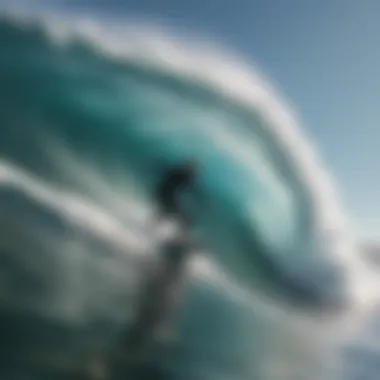
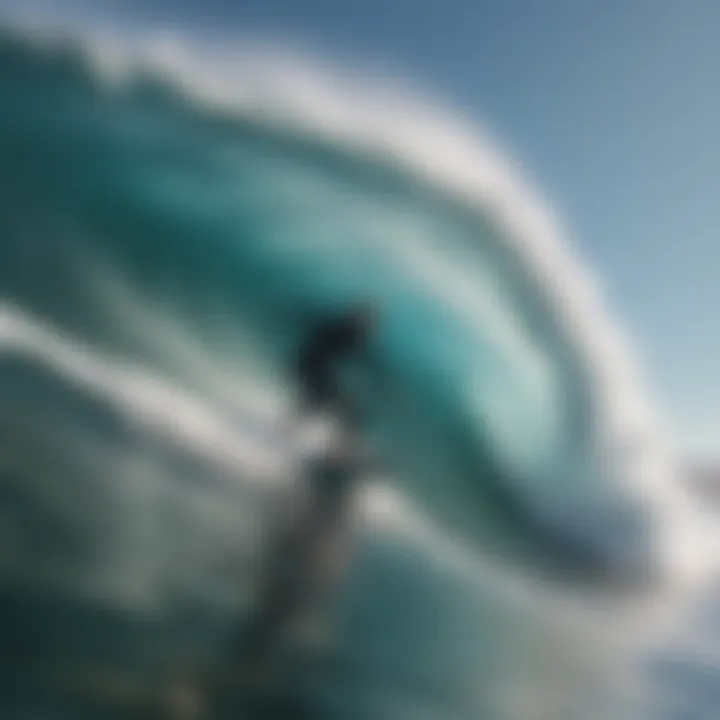
Advantages: Effective positioning can enhance performance, making for smoother transitions and opportunities to catch additional waves.
Disadvantages: This skill also demands a nuanced understanding of wave dynamics, which can take time to develop.
Surfers who educate themselves about wave dynamics will ultimately find more joy and safety in their surfing endeavors.
Safety Considerations in Wave Braking
When it comes to surfing, understanding wave braking isn’t just about catching the perfect wave; it’s equally about knowing how to stay safe while doing so. Safety considerations in wave braking center on managing risks associated with the ocean environment, which can change in the blink of an eye. From rip currents to underwater hazards, becoming aware of these elements can make a world of difference for surfers at all experience levels.
Understanding Rip Currents
Rip currents are powerful, narrow channels of water that move away from the shore. These currents can be deceptive, making them a top concern for surfers. Knowing what a rip current looks like is crucial. Typically, you might spot a gap in the waves, foam, or even a color difference in the water that sets it apart from its surroundings.
Surfing knowledge isn't just for riding waves; it plays a significant role in ensuring one's safety. If you find yourself caught in a rip current, it's important to remain calm. Instead of paddling against the current, try swimming parallel to the shoreline until you break free. Then, swim towards the waves at an angle to safely return to the beach.
"Awareness is your best ally when dealing with the hidden dangers beneath the surface."
Avoiding Hazards
While surfing can be thrilling, hazards often loom beneath the quaint surface of seemingly calm waters. Staying informed about potential dangers, especially in familiar spots, can save lives and enhance the overall surfing experience.
Reefs and Rocks
Reefs and rocks are common features along coastlines. They often create those adrenaline-pumping breaks surfers seek, but they can also pose serious risks. When navigating around these areas, understanding the local geography helps avoid collisions and injuries. Due to their solid structure, reefs can create sharp surfaces that lead to cuts or worse when a surfer falls. It's wise to familiarize oneself with the layout of the sea floor before diving into any surf, especially in unfamiliar territories.
Furthermore, some reefs absorb and channel wave energy effectively, presenting ideal surfing opportunities. However, safety measures can't be overlooked, as those who underestimate the danger may find themselves needing more than a basic first aid kit.
Strong Currents
Strong currents can dramatically affect wave dynamics, making it essential for surfers to read ocean conditions accurately. These currents are often relentless as they push against incoming waves, leading to increased turbulence.
Being aware of strong currents not only enhances your safety but also increases your surfing proficiency. For surfers eyeing a particular break, knowledge of the current's strength can dictate timing and positioning. Surfers often say that understanding currents is akin to reading the ocean's poetry; the rhythm it creates can teach where to paddle and when to ride. However, the unpredictability means that even the most seasoned surfers must be vigilant.
In summary, safety considerations while engaging in wave braking are paramount for enhancing the surfing experience. The collective knowledge about rip currents, reefs, rocks, and strong currents serves as a cornerstone for both personal safety and improved surfing skills.
The Future of Wave Dynamics Research
As the world grapples with changes in climate and environmental degradation, the significance of ongoing research in wave dynamics becomes ever more pronounced. While surfers experience the results of these natural processes firsthand, the science behind it plays a pivotal role in understanding how waves behave and the conditions that create those iconic swells. This section delves into the cutting-edge advancements and sustainability considerations that are shaping the future of this field.
Technological Advances
Research into wave dynamics is being transformed by technological innovations that enhance our understanding of ocean behavior. Through the use of remote sensing technologies such as satellites and drones, scientists can accurately monitor wave patterns and their interactions with the coastal environment. These advancements allow for more precise predictions regarding wave behavior, which can be beneficial both for surfers seeking optimal conditions and for coastal communities aiming to manage erosion and flooding risks.
Additionally, the development of high-frequency radar systems helps track waves in real time. This technology continuously collects data on wave heights and directions, enabling surfers to receive current information straight from their mobile devices.
Here are a few examples of significant tech developments in this area:
- Numerical models that simulate wave interactions, providing a virtual environment to test hypotheses regarding wave behavior.
- Artificial intelligence systems that analyze historical data to predict future wave behaviors based on patterns.
- Interactive apps that provide surfers and researchers with apps for immediate data access on wave quality, making it easier to read the ocean.
With these advancements, not only surfers can enhance their experiences, but also local governments can better prepare for severe weather events influenced by wave dynamics.
Sustainability Issues
The intersection of wave dynamics research and sustainability has never been more relevant. Coastal areas face the brunt of climate change, and understanding wave behavior is crucial for developing strategies that mitigate potential negative impacts. Stronger storms and rising sea levels threaten coasts; however, ongoing research is paving the way for responsible management of these vital ecosystems.
One key issue in sustainability is the balance between wave energy harnessing and preserving surf ecosystems. As renewable energy technologies evolve, the placement of wave energy converters must consider the effects on marine life and surf conditions. Researchers are working to determine how to harness energy from waves without disrupting the natural wave patterns that create surfable conditions.
Furthermore, with rising global temperatures and changing weather patterns, maintaining healthy coral reefs and marine habitats is imperative. Knocking on the door of sustainability, scientists are advocating for practices that reduce pollution and overfishing—both of which directly impact the dynamics of waves and the overall health of the ocean. By fostering a deeper understanding of how such human activities influence waves, the surfing community can also engage in conservation efforts that protect their beloved waves.
"Understanding waves is not just about riding them—it's about respecting the ocean, and so we must be its stewards."
Researchers and surfers alike have a role in shaping the future landscape of wave dynamics, making it an essential area of study and advocacy.
Ending
When it comes to surfing, understanding wave braking is not just about catching a good ride; it’s about safety, technique, and even respect for the ocean. The dynamics of wave braking shape surf conditions, and mastering this knowledge can vastly enhance a surfer's experience, whether they are a novice or a seasoned rider.
Summary of Key Concepts
Throughout this article, we've examined several crucial aspects related to wave braking:
- Wave Formation and Mechanics: We discussed how wind influence, fetch distance, and water depth work together to create waves. Recognizing these elements helps surfers better anticipate conditions.
- Types of Wave Breaking: Different breaks—like plunging, spilling, and collapsing—each have unique properties that dictate how a wave behaves as it approaches the shore.
- Environmental Influences: Wind patterns, ocean currents, and tides are factors that influence wave dynamics, affecting everything from safety to surfing strategies.
- Techniques and Safety: Knowing how to read the ocean, time the drop-in, and understand hazards like rip currents can help surfers not only enjoy their time on the water but also stay safe.
By internalizing these concepts, surfers can not only better their skills but also develop a deeper connection with the surf environment, paving the way for a more complete understanding of the ocean's behavior.
Final Thoughts on Wave Braking
Wave braking is an intricate and vital phenomenon that needs to be understood by anyone looking to engage in surfing effectively. Emphasizing practicality, surfers can benefit from this knowledge through improved performance and safety. The ocean is unpredictable, and while we might not control its elements, being informed allows us to navigate its challenges with confidence.
Adapting to wave conditions is an art, one that requires practice but also an appreciation for the science behind it.
"The sea is a curious beast, and those who don't learn her rhythms may find themselves out of sync and out of luck."
As surfing continues to evolve with advances in technology and environmental awareness, staying educated about wave dynamics will be paramount. The future of wave dynamics research promises to unravel even more details about waves, ensuring that surfers have more tools at their disposal to understand and appreciate this fascinating element of nature.















